The best camping stoves: backpacking and double-burner stoves
Our roundup of the best camping stoves features everything from lightweight backpacking beauties to meaty double burners for campsite cuisine

Whether firing up for a balmy night time feast, or warming up after a hard winter's hike, your camping stove is an essential piece of kit you can't afford to leave behind. And we all know food cooked on a camp fire somehow tastes better than the stuff you make at home.
In this guide, we feature a range of excellent lightweight backpacking stoves, designed to be compact enough to slot into your backpack and to give you a reliable heat source in the wild. Some are designed to bring water to the boil in no time, while most feature integrated pots, making them hugely packable.
Then, we delve into the best double-burner stoves; bigger units for the campsite. These offer the ability to have multiple pans on the go at once and a greater level of control for more nuanced cooking. Finally, we feature a great wood-burning option too.
The best camping stoves
You can trust Advnture
Best camping stoves overall
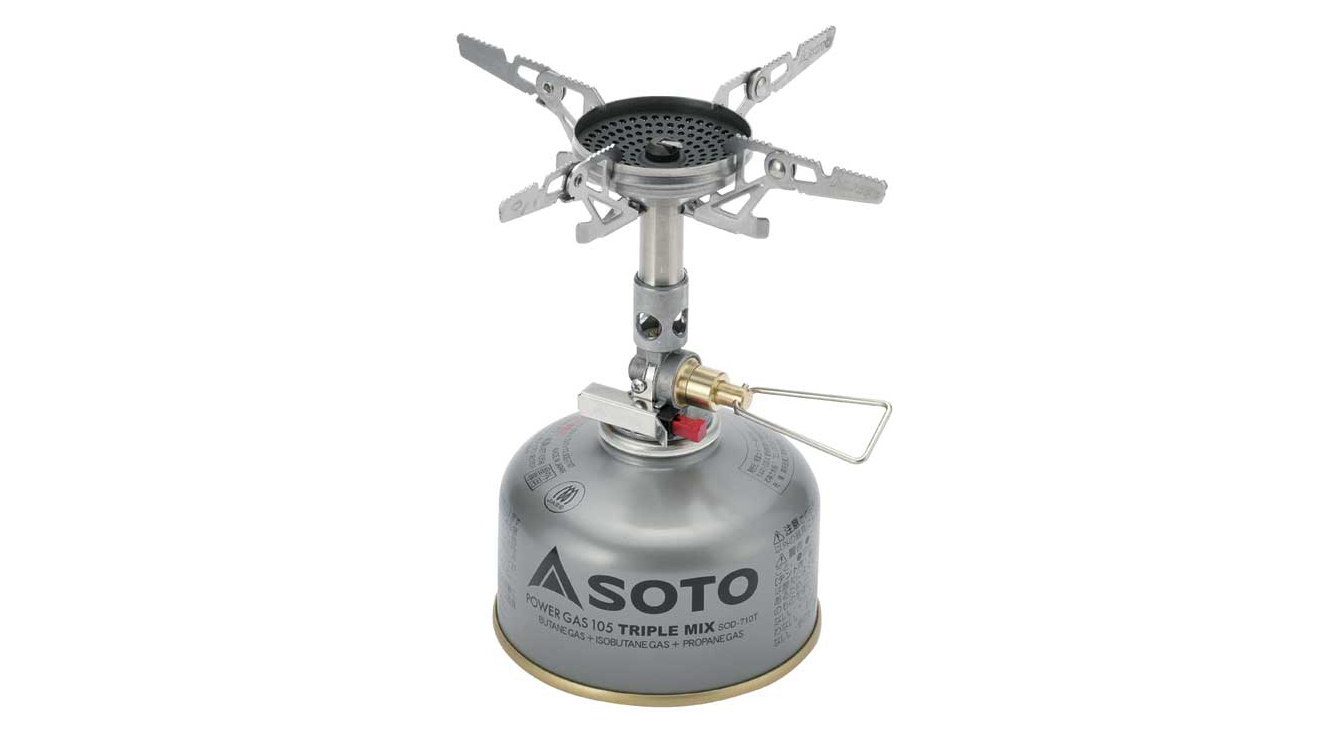
Specifications
Reasons to buy
Reasons to avoid
As a classic screw-in type stove, the SOTO Windmaster has all the traditional advantages of a conventional canister-top design, namely, quick and easy set-up plus minimal weight and pack size. This makes it a good choice for extended backpacking trips or fast and light missions. However, as its name suggests, the Windmaster also offers superior performance in breezy and gusty conditions compared to most of its screw-in rivals.
The secret is its effective engineering. The concave burner head has a small but well-designed protective lip, while the low-profile pot support places the pot very close to the flame. Together, these features combine to offer excellent wind-resistance.
Where a sudden gust often blows other canister-top stoves out, this one just keeps on burning. It also offers fairly precise simmer control, which makes cooking easier. The four-pronged pot support is stable in use, while the wide burner head distributes heat evenly.
Unlike cheaper stoves, the Windmaster also has some clever hidden tech. This includes a micro regulator for more consistent power output, even when temperatures drop or when your gas is running on empty. There’s also an integrated ignition, which is always a useful extra. This one is neatly enclosed within the burner stem too, while the sparker at the burner head is a strip of metal rather than a flimsy piece of wire, which makes it less liable to get brittle and snap.
Read our full SOTO Windmaster review

2. Optimus Vega
Our expert review:
Specifications
Reasons to buy
Reasons to avoid
A serial winner of outdoor magazine gear tests, the Optimus Vega is one of the few stoves designed to take winter temperatures in its stride. Flip the gas canister upside down (there are support legs to hold it in place) and the heat gets a ‘Turbo Boost’ – ideal for cold temperatures or if you need to cook in a hurry. Boiling or cooking in sub-zero temperatures may sound extreme, but early mornings at altitude in summer can see the mercury tumble. This winter mode does burn more fuel, so for summer it’s wiser to save gas and have the canister the right way up. The stove itself sits low to the ground, which makes it more stable, and a foil windshield shelters the flame from a breeze.
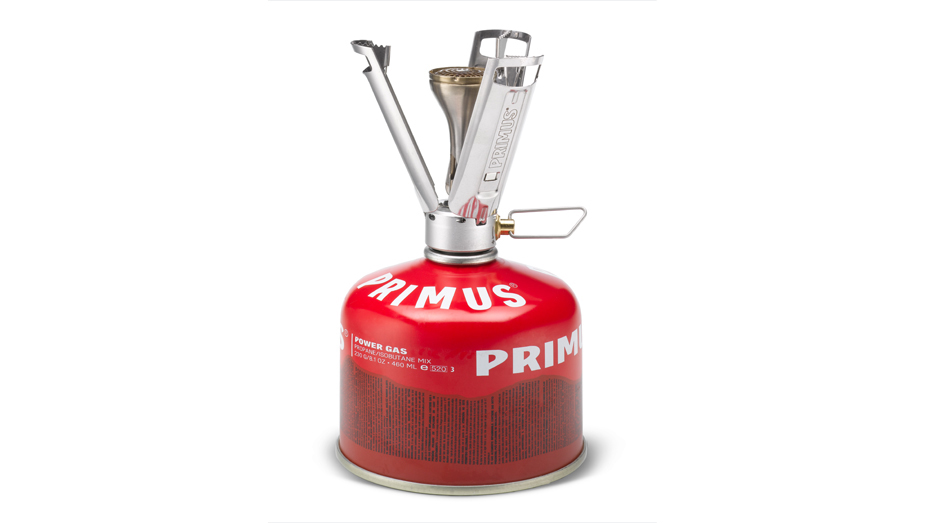
3. Primus FireStick
Our expert review:
Specifications
Reasons to buy
Reasons to avoid
As all experienced backpackers know, the pointy edges of a stove can stick out in a backpack and burners are vulnerable to knocks. Primus has solved both of these issues with the innovative FireStick, which folds into a cylinder similar in size to a fat tube of sweets, with the arms that support a pan during cooking clicking together, protecting the burner.
The stove screws on to a gas canister, creating a tall, reasonably wide platform, and a regulated valve lets campers adjust the flow of gas and thereby control the temperature. The wide arms also provide a degree of wind protection. If saving weight is a priority, a titanium version of the same stove shaves off 16g (0.6 oz) and costs $30 (£30) more.

Specifications
Reasons to buy
Reasons to avoid
With its ‘Easy Clic’ connection to the gas bottle and in-built ignition system (the piezo or P) the Campingaz Twister Plus PZ is a quick and simple stove to set up, and there’s no fumbling around for matches or cursing as the wind blows out a match before you’ve had a chance to light the burner. A neat heatshield protects your fingers from the flame as you turn the knob that adjusts the supply of gas and heat.
When not in use, the hard, plastic case provides more protection than many carry solutions for stoves. Just be aware that it will only work with canisters that have the Campingaz Easy Clic valve.
Read our full Campingaz Twister Plus PZ review
The best all-in-one camping stoves

Specifications
Reasons to buy
Reasons to avoid
It’s deeply satisfying to be able to pack up a cook system into a compact bundle, rather than have a separate stove, pot and gas canister. With the FyreStorm PCS, the stove and a small gas canister fit inside the pot for great portability. In use, the long hose keeps the gas canister away from the stove, the piezo ignition delivers a match-free spark to the gas, and the wind shield shelters the flame from the breeze.
The heat is adjustable, allowing for a vigorous boil or a simmer, while the lid and neoprene sleeve provide extra precaution against accidental scalding. So that’s all bases covered for campsite chefs.
Read our full Coleman FyreStorm PCS review
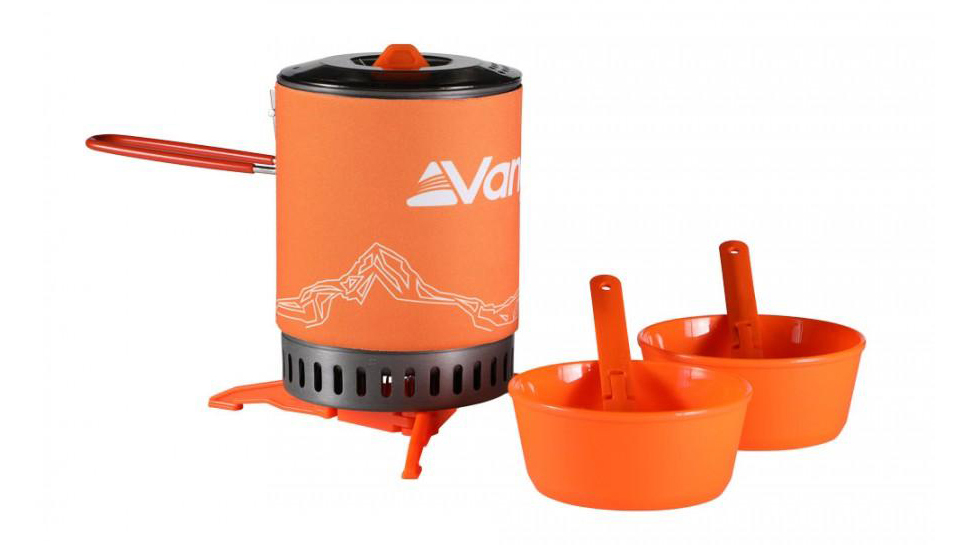
Specifications
Reasons to buy
Reasons to avoid
If you’re attracted to the convenience of personal cooking systems like the popular Jetboil MiniMo or the MSR Windburner but can’t afford the sizeable price tag, this kit is well worth a closer look. It bundles Vango’s ultralight Atom stove with a sturdy cooking pot and various accessories, giving you pretty much all you need to knock up a basic meal for two hungry hikers. As such, it’s a far more affordable alternative to those pricier all-in-one stove systems.
The no frills Atom stove is basic but extremely light and compact, with a competitive power output of 3,000w. The Vango pot, which simply sits on top of the stove’s spindly folding arms, has a practical real-world capacity of 1 litre. This is larger than most, making it easier to cater for two, whether you’re heating water for backpacking rations or just brewing up two steaming mugs of tea or coffee.
The pot has a similar heat exchanger base to the Jetboil design, resulting in improved fuel efficiency and faster boil times. It also has a chunky clear plastic lid with an easy-grab silicon tab and a sturdy folding handle – simple and straightforward features, but ones which plenty of other brands seem to get wrong.
The Vango cook kit also includes two small plastic bowls and folding sporks, plus a gas canister stand. It all packs away neatly into the pot, with room to spare for a 230g gas canister (which is the bigger size that you’ll find stocked in most camping shops). It’s a tidy system that is comparable in overall weight to most Jetboil systems, though it is admittedly a bit bulkier due to the larger capacity cooking pot.
Read our full Vango Atom and Ultralight Heat Exchanger review
The best fast boiling camping stoves
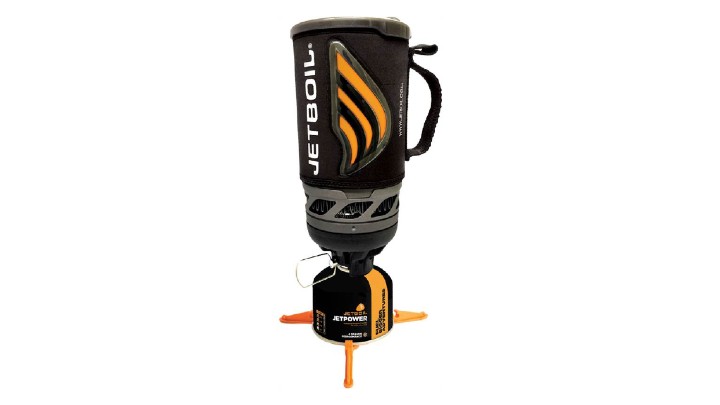
Specifications
Reasons to buy
Reasons to avoid
For any backpacker in urgent need of a cuppa, there’s only one place to turn. The Jetboil Flash is astonishingly fast to boil water, its FluxRing roaring away like a… well, jet. This makes it ideal for rehydrating dried meals, as well as brewing a tea or coffee (an optional £15/$20 coffee press turns the pot into a cafetiere). Fold-out legs attach to the base of the gas canister, improving stability; push button ignition starts the fire without messing around with matches; and a color-change heat indicator shows when water is boiling (if plumes of steam haven’t given you a clue). For portability, the stove and a small gas canister slide into the pot, while a small bowl protects the FluxRing.
We’ve been using a first generation Jetboil Zip for almost a decade, the stove sounding the death knell for our flask, and it’s still a pack essential for any long day in the hills.
The best two-burner stoves
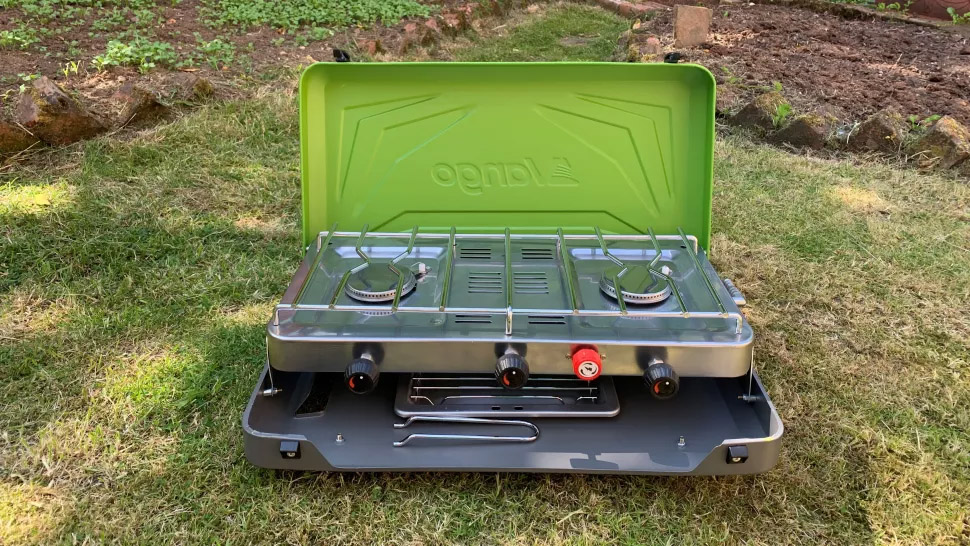
Specifications
Reasons to buy
Reasons to avoid
If you’re looking for a budget-friendly but reliable solution to cooking for a crowd at camp, look no further than the Vango Combi IR Grill Compact. With two burners over a surface area of nearly 19in x 11in, you can cook with two large pots or skillets as well as the infrared grill underneath. All three are powered by one ignition switch and we found they provided a good heat source with good fuel efficiency too.
Powered by a butane gas bottle, once this is hooked up we were able to set it on any surface thanks to its anti-slip feet. The lid provides some wind protection, but it doesn’t have side panels so if you’re cooking on a gusty day you’ll want to hang a tarp or find a sheltered area. Whenever we'd finished cooking, it cooled quickly and was really easy to clean. To pack it up, all we had to do was close the lid and fasten the latches to carry under one arm back to the car. We found the plastic locking latches a bit fiddly at first and they seem a bit cheap, plus we’d love a carrying handle, but for the price you really get a lot for your money here.
Read our full Vango Combi IR Grill Compact review
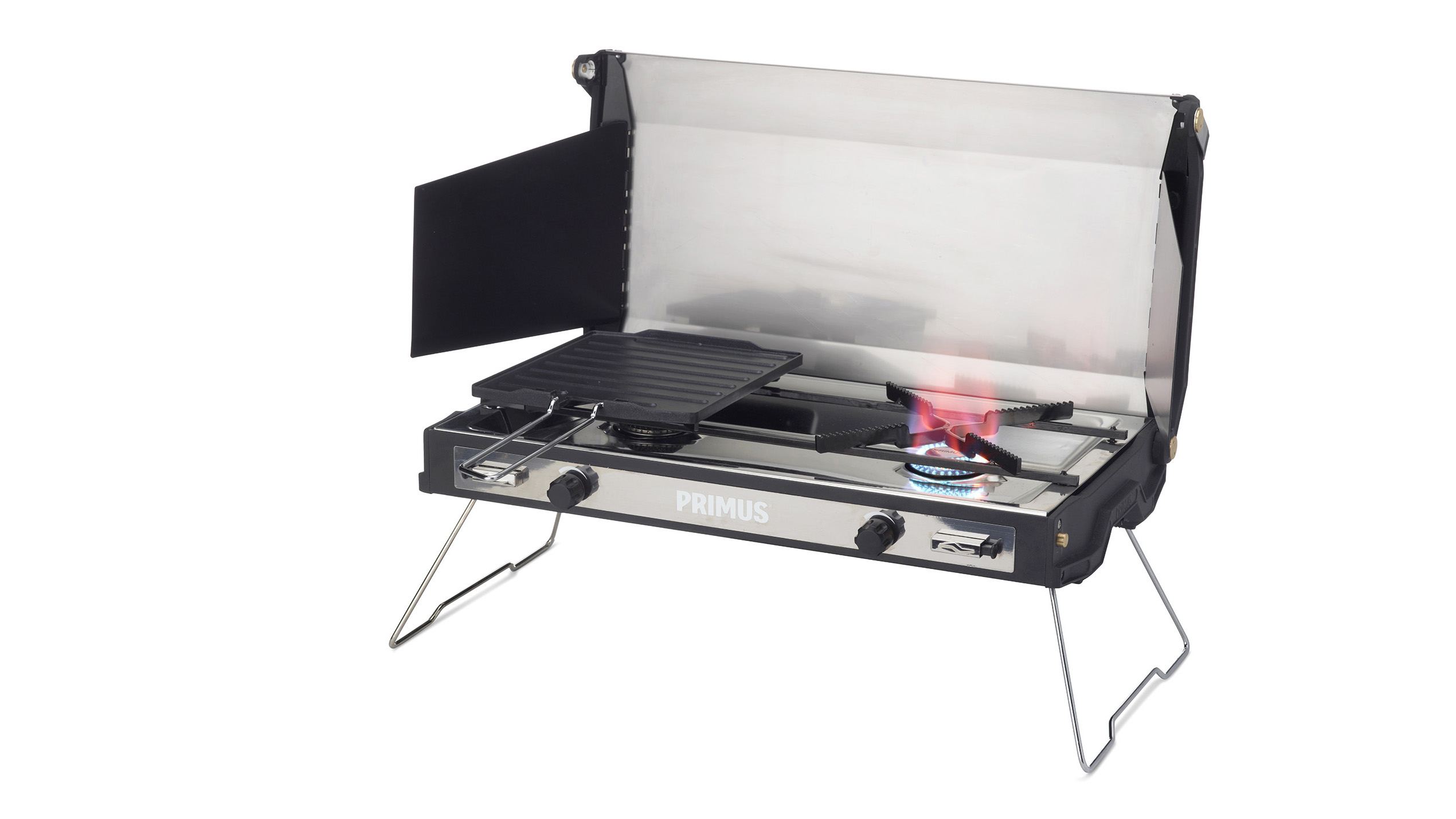
9. Primus Tupike Portable Stove
Our expert review:
Specifications
Reasons to buy
Reasons to avoid
The Tupike comes with a non-stick griddle, which enables you to add more variety to the camp menu. After dinner, a stainless steel drip tray and removable pot supports make clean-up quick and easy. When not in use, the wooden handle locks the stove cover in place. Inside, a spring-action lock holds the regulator safe and secure.
The Tupike’s stainless steel, oak, and brass construction turns a utilitarian piece of outdoor equipment into a work of art. And when it’s time to cook, don’t worry if you left the matches at home – with the piezo ignition, the burners fire up without matches or a lighter. Individually controlled twin 10,000 BTU burners allow the camp chef to boil water quickly for pasta, while simultaneously simmering the sauce. Folding steel legs lift the stove higher off the camp table for more comfortable cooking ergonomics. The cover and adjustable side panels shield the burners on windy days.
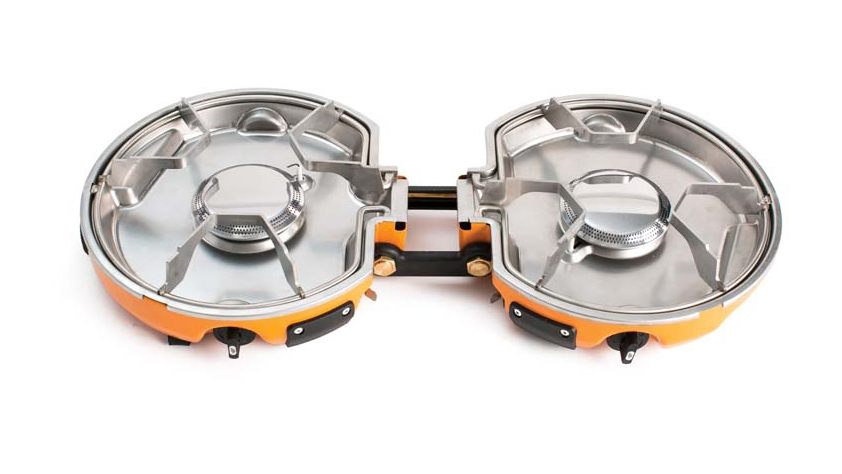
10. Jetboil Genesis Base Camp Stove
Our expert review:
Specifications
Reasons to buy
Reasons to avoid
Traditional two-burner camp stoves start with a rectangular box of stainless steel or aluminium, but Jetboil’s Genesis stove brings a completely different approach to camp cooking. This neat circular stove design stacks two burners for transport and storage. At camp, the unit unfolds, ignites easily and twin burners deliver 10,000 BTUs of heat. In our tests, it took just three minutes to have boiling water ready for coffee or pasta. The stove can be linked with other stoves to create a series of burners to feed a hungry crew and works efficiently paired with Jetboil’s cookware system options.
Attaching the windscreen when the winds kick up keeps the cooking process in high performance mode. Compatible with a standard propane bottle, the kit includes a stuff sack with a separate pocket to protect the regulator.
Small, compact and light, the Genesis two-burner stove is a very worthy addition to a short camping trip.

11. Coleman Triton Propane 2-burner
Our expert review:
Specifications
Reasons to buy
Reasons to avoid
The two basic components needed for a memorable camping trip are food and shelter. Feeding a gang of hungry campers requires a tasty menu, fresh ingredients and a way to bring it all to life, and Coleman’s Triton camping stove tackles that job with ease. Propane powers 22,000 BTUs through two independently controlled burners. With a 12in and 10in pans cooking side by side, there’s plenty of room for variety when it comes to answering the inevitable “what’s for dinner?” question.
Coleman stoves use pressure-control technology to deliver consistent heat even in cold, windy temperatures, and when you have a half-empty fuel bottle. Adjustable wind panels help too. With enough heat to cook a feast for a hungry family, the Triton stove should be at the top of your gear shopping list.
The best wood-burning camping stove

Specifications
Reasons to buy
Reasons to avoid
Solo Stoves bring out the hunter-gatherer in campers, due to their fuel source – twigs. Children will love foraging around for dry tinder to burn, and there’s something deeply satisfying about being self-sufficient, rather than relying on gas. However, there’s always the risk that heavy rain will have soaked available twigs or that there’s no combustible material around (an alcohol burner is available as an accessory for £22.50/$20).
The Solo Stove has a double combustion process – oxygen drawn in through the bottom vents feeds the main combustion, while heated air rising through the double wall is fed through the top vents for an extra oxygen boost, enhancing the stove’s efficiency. Cooking pots and kettles then perch on top. This stove is slightly heavier than others, but you save weight by not having to carry fuel.
Read our full Solo Stove Lite review
Camping stove comparison table
| Camping stove | RRP | Packed weight | Boil time |
| SOTO Windmaster | $65 (US) / £55 (UK) | 100g / 3.5oz | 2min 14secs (500 ml) |
| Optimus Vega | $95 (US)/£105 (UK) | 178g / 6.3oz | 4 mins 30 secs (1000 ml) |
| Primus FireStick | $90 (US)/£90 (UK) | 105g / 3.7oz | 3 mins 30 secs (1000 ml) |
| Campingaz Twister Plus PZ | £30 (UK) | 274g / 9.6 oz | 3 mins 45 secs (1000 ml) |
| Coleman FyreStorm PCS | £75 (UK) | 486g / 1lb 1oz | 4 mins 30 secs (1000 ml) |
| Vango Atom and Ultralight Heat Exchanger | Full set: £65 (UK) | 507g / 17.9oz | 2min 38 secs (500 ml) |
| Jetboil Flash | $110 (US) / £120 (UK) | 371g / 13oz | 1 min 40 secs (500 ml) |
| Vango Combi IR Grill Compact | £90 (UK) | 3.87kg / 8.5lbs | N/A |
| Primus Tupike Portable Stove | $250 (US) / £250 (UK) | 9.5lb / 4.3kg | N/A |
| Jetboil Genesis Base Camp Stove | $260 (US) / £250 (UK) | 6.2lb / 2.8kg | N/A |
| Coleman Triton Propane 2-burner | $75 (US) / £75 (UK) | 4lb 13oz / 2kg | N/A |
| Solo Stove Lite | $90 (US)/£90 (UK) | 255g/9oz | N/A |
How we test camping stoves
At Advnture we endeavor to test every product we feature extensively in the field. That means one of our team of reviewers and writers – all experienced outdoor specialists active across the US, UK, Europe and Australasia – taking it out into the terrain and climatic conditions that it’s designed for. If, for any reason, this isn’t possible, we’ll say so in our buying guides and reviews.
Our reviewers test camping stoves in a range of outdoor scenarios – car camping, backpacking, base camping – assessing their value and performance against the claims of the brand in terms of heat output, fuel consumption, packability, simmer control, weight, ease of assembly/packdown, transportation, robustness and features.
For more information, see how Advnture test products.
Choosing the best camping stove for you
Whether you're taking the kids on a camping break or going fast and light in the mountains, getting the right camping stove is an important decision. Getting some warm sustenance into your system after a day of hiking is a vital factor in making any backpacking or camping trip a success. That's why a good stove is so high on our camping checklist.
The best camping stove for you is the one that suits your ambitions. In this day and age, the variety of stoves and the myriad features they offer can be a little bit overwhelming too. Many backpacking stoves are designed to be lightweight and stable in a strong wind, while others boast rapid boil times. If you're cooking for the kids from your camping chair, you might want a dual-burner stove that can take a couple of large cooking pots, rather than something designed for one.
These are the most important factors to consider when choosing the best camping stoves:

1. Boil times
The equivalent of a car’s 0-60mph acceleration time, most manufacturers will advertise how long it takes a stove to boil 0.5 litres of water. The time is only a guide, and depends on how much gas is left in the canister, the ambient temperature, the strength of the wind (and the effectiveness of any windshield), the type of gas (typically propane/butane), and even the shape and insulation (lid) of the pan. If you're sometime who likes to fill your camping mug up quick and get back on the go, look for a speedy boil time.
Note: Water boils at 100°C (212°F) at sea level, but for every 150 metres (500ft) you ascend the boiling temperature drops by about 0.5°C (just under 1°F). At 2,400 metres (8,000ft), about halfway up Mont Blanc, water boils at just 92°C (198 °F).
2. Ignition
A built-in piezo igniter, similar to the spark-creator of a domestic gas hob, is most convenient for lighting gas, but some stoves rely on matches.
Imagine you've braved the elements for hours, are soaked to the skin and the only thing keeping you going is the thought of that freeze-dried meal and a piping hot cup of coffee. You find shelter in the woods, hastily erect your best one-person tent and reach for your matches. They're sodden. At this point, you're going to wish you had a stove with a built in igniter.
A stove that requires matches is fine for family holidays, where you can store them in the car or know they'll stay dry in the tent, but for expeditions in the wild you might want to consider an igniter.
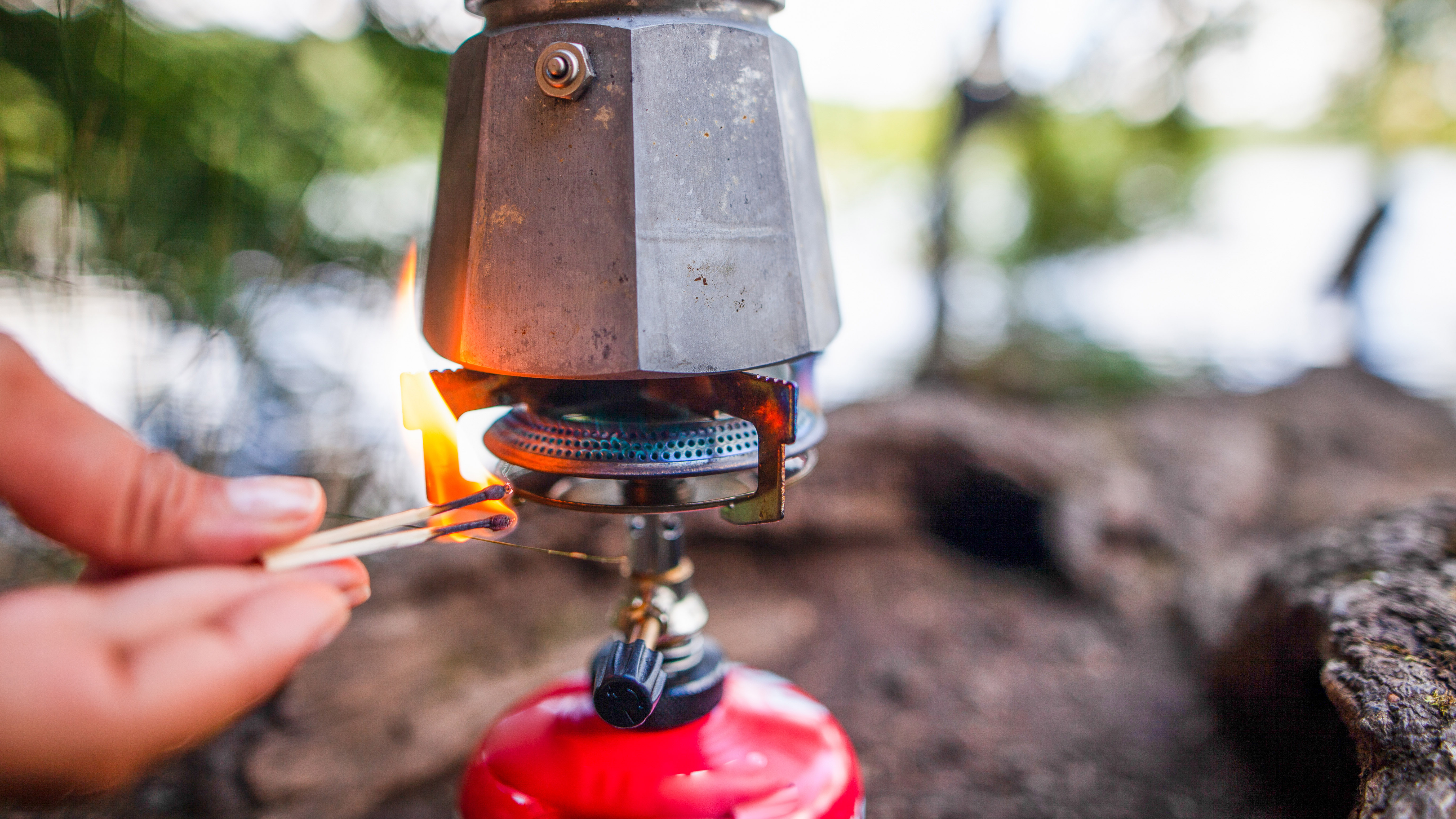
3. Windshield
A decent breeze can seriously impact the performance of the best camping stoves, so a protective windshield around the burner is a useful feature. There's nothing more frustrating then waiting an age for that water to boil when it is blowing a hoolie, which is likely if you're wild camping up high.
Consider what you are willing to compromise on. A windshield is great if you're camping in the mountains, but it does represent a little bit of extra weight, not ideal if your priority is going fast and light. Can you instead check the wind direction and plan to camp in a sheltered spot? Can you use natural barriers like boulders or trees to find that shelter?

4. Size and weight
If you're peak bagging and looking to shave off every last gram so that you can merrily skip from summit to summit, you're going to need a lightweight stove. There's no point setting out with the best lightweight camping gear if your stove weighs a ton.
However, a strong, stable stove with a wide diameter burner and a broad pan support is very reassuring when you’re chopping veg up with your camping knife and throwing it into a pan alongside a vat of pasta in boiling water.
Most of the weight will be in the gas canister anyway, so it’s the stove’s fold-up size that matters more – some will encase the burner and gas canister inside their cooking pot.
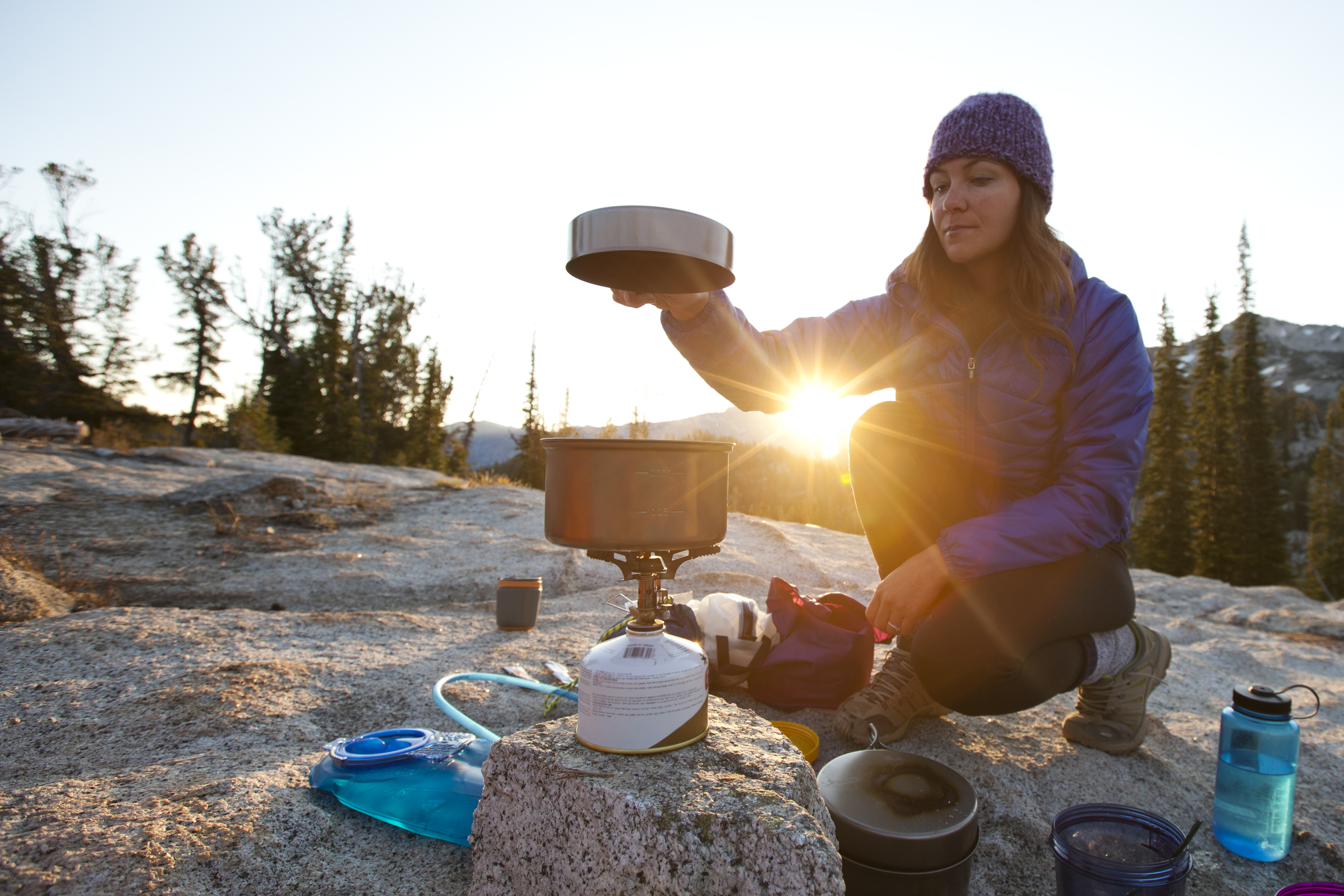
5. Burn control
Boiling water may be a race to 100 degrees, but there are occasions when it’s very handy when the best camping stoves have the ability to regulate the heat for more sensitive cooking. If you're just making a brew or heating an vacuum-packed backpacking meal, this won't apply.
However, if you're trying to do your best Heston Blumenthal impression with all your camping utensils in an attempt to impress the other campers, you'll want easy access to the flame-control valve. The last thing you want is burnt sausages.
6. Canister compatibility
Most stoves will connect to a screw-thread canister, but some, such as Campingaz, have a non-thread connection, so will only work with a non-threaded, Easy-Clic canister, which could be limiting if you need re-supplies in a far-flung area. If you’re concerned, small adapters are available.
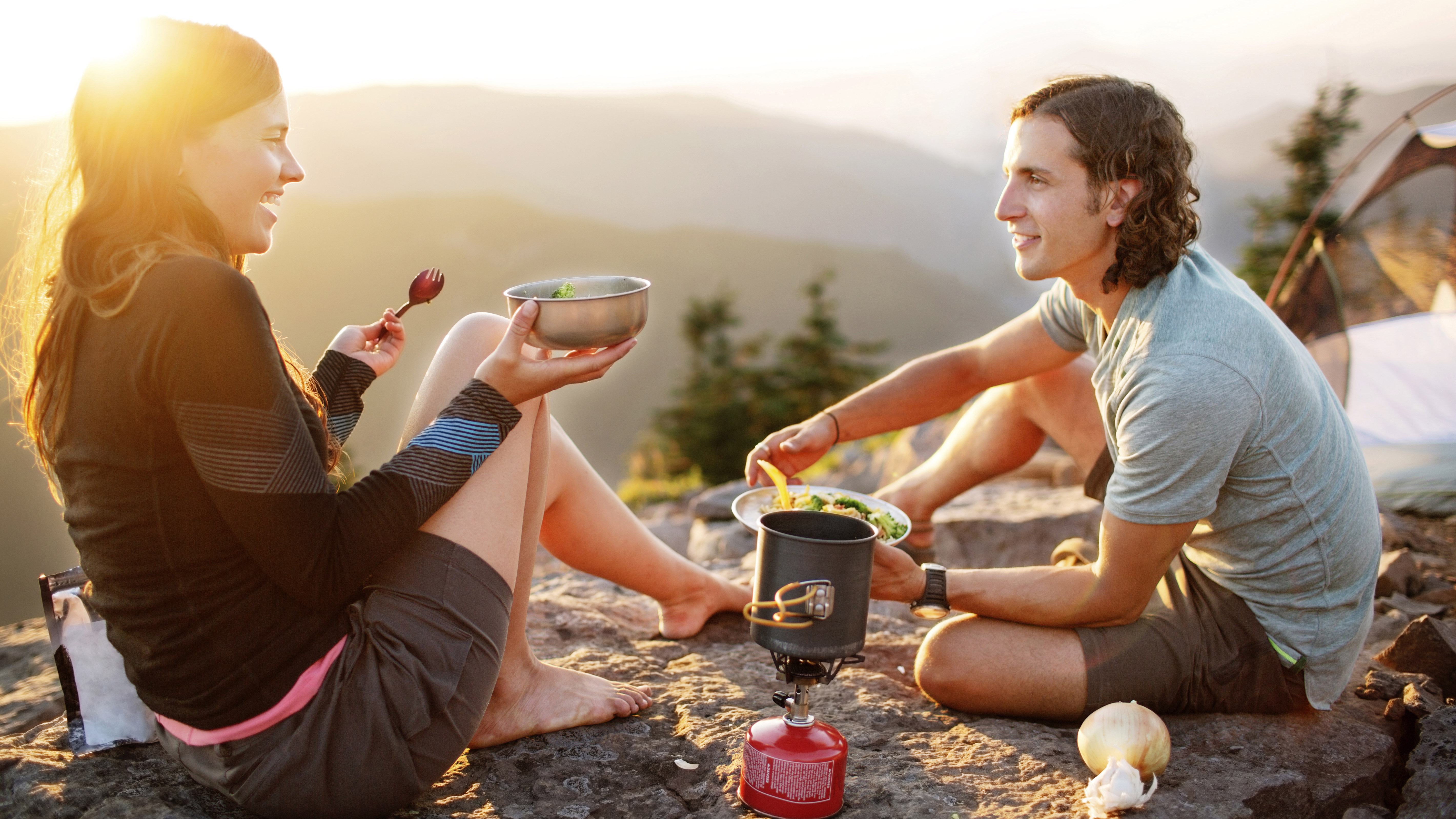
7. Fuel type
Most of the best camping stoves burn a mix of propane and butane. Propane is better for colder temperatures, and butane for warmer weather. If you're going to be heading out for a winter wildcamp, look for a canister with a higher propane content. Whereas, butane is ideal for the perfect summer camp.
Some multi-fuel stoves can also burn paraffin (kerosene) and unleaded petrol, which work better at higher altitude and can be easier to source in remote areas of the world.
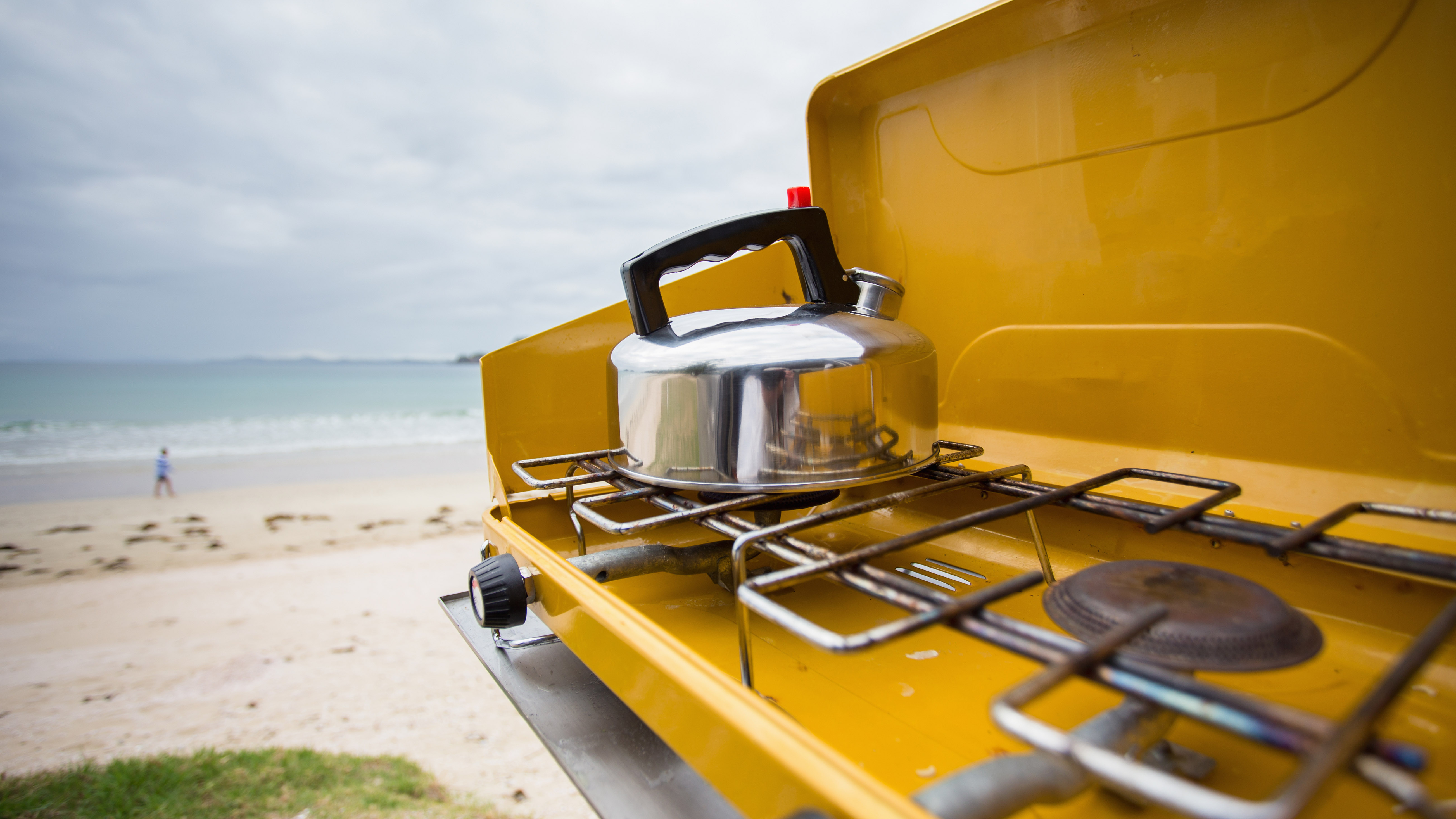
8. Stove type
Screw-in or integrated upright canister camping stoves: Probably the most popular type of stove for most backpackers and wild campers, these stoves consists of a lightweight burner head that screws on to the top of a propane, butane, or isobutane gas canister. While lightweight, highly packable, and very easy to use, these stoves often aren't the most powerful and don't perform quite as well as others in windy conditions.
Best for: all-around backpacking, thru-hiking, and wild camping.
All-in-one/personal cooking system: These consist of a burner head with a screw-in fitting along with an integrated cooking pot. Both components lock together in a compact nesting system, making them the second most packable varietal after screw-in/integrated models. Generally, these systems offer fast boil times and excellent fuel efficiency, even when you're doing your cooking in windy conditions.
Best for: solo campers or couples who value convenience and efficiency.
Liquid fuel and multi-fuel camping stoves: These run on white gas, kerosene (paraffin) or petrol, and some multi-fuel stoves (like the MSR Whisperlite) can run on all three. Generally speaking, these stoves are robust, reliable, and work well in all conditions. On the downside, they do tend to be heavy, bulky, and require frequent cleaning and maintenance.
Best for: large groups or for expedition basecamp use.
Wood camping stoves: These stoves run on foraged fuel such as twigs, pinecones, and other small pieces of wood. While this does mean you'll need to find these when you get to your campsite, it also means you won't have to carry fuel from home on your trip.
Best for: lovers of old-school aesthetics and/or campers who would prefer to forage for fuel rather than schlep it into the wilds in their backpacks.
Hose-fed/spider camping stoves: These stoves have a burner head that sits on tripod legs and a braided metal hose that attaches to a gas canister. Because these stoves sit closer to the ground, they are typically more stable and burn better in strong winds than their screw-in siblings. On the downside, spiders are usually much bulkier and heavier.
Best for: Backpacking and wild camping in a larger group.
Alcohol camping stoves: These stoves burn non-pressurised denatured alcohol (methylated spirits or ‘meths’). While cheap and ultra-reliable, they offer no control over power output, are slower to cook, and not as fuel efficient as gas canister-type stoves or pressurised liquid fuel stoves.
Best for: Campers and backpackers on a budget, Scout and DofE groups.
Solid fuel camping stoves: These are simple, compact and lightweight stoves that were originally developed for use by the military. Solid fuel is smokeless, energy-efficient and leaves no ash, but is highly toxic, so can only be used in well-ventilated areas.
Best for: gram counters and minimalists.
Single/double burner camping stoves: These stoves have one or two full-size burners and normally use tall ‘twist and click’ butane (or propane-butane) canisters or larger, refillable gas bottles. Cooking with one of these stoves is very similar to cooking on the stove at home - they have auto-ignition, great simmer control, and are are far more powerful than models designed for backpacking. On the downside, they're far too bulky and heavy to be carried any kind of distance.
Best for: family car-camping trips
All the latest inspiration, tips and guides to help you plan your next Advnture!
Alex is a freelance adventure writer and mountain leader with an insatiable passion for the mountains. A Cumbrian born and bred, his native English Lake District has a special place in his heart, though he is at least equally happy in North Wales, the Scottish Highlands or the European Alps. Through his hiking, mountaineering, climbing and trail running adventures, Alex aims to inspire others to get outdoors. He's the former President of the London Mountaineering Club, is training to become a winter mountain leader, looking to finally finish bagging all the Wainwright fells of the Lake District and is always keen to head to the 4,000-meter peaks of the Alps. www.alexfoxfield.com
- Louis Dzierzak
- Kim FullerAdvnture contributor

